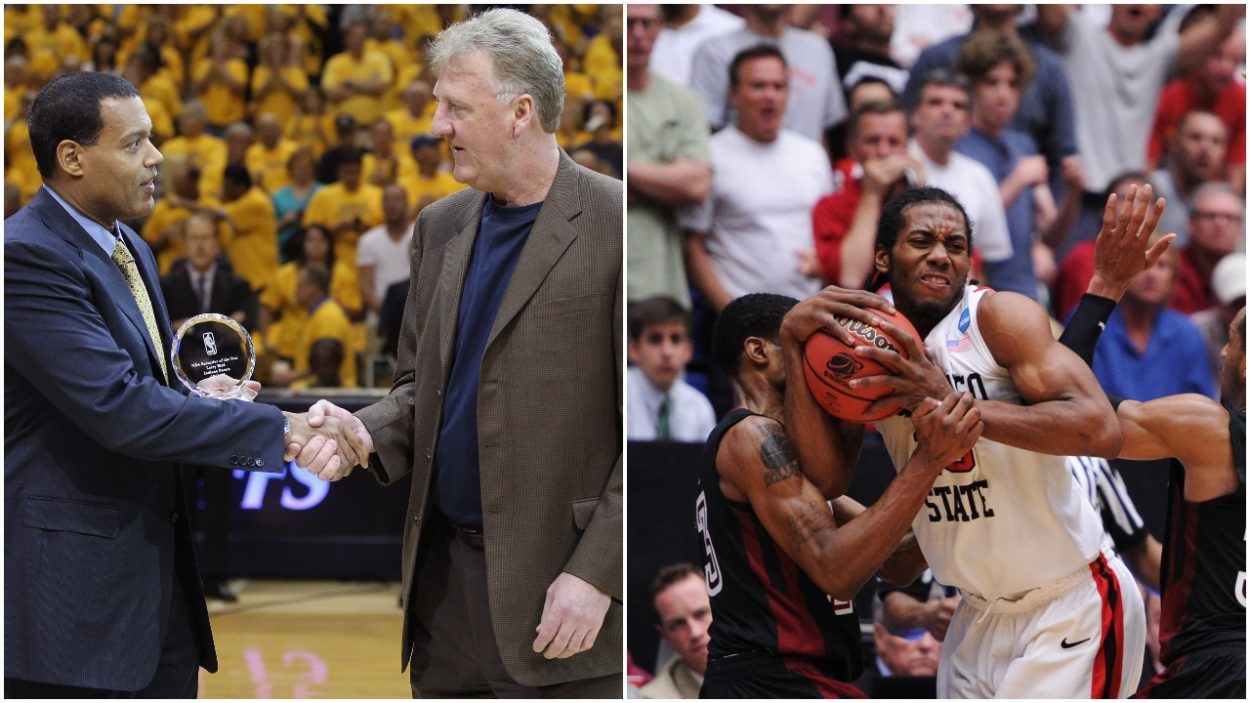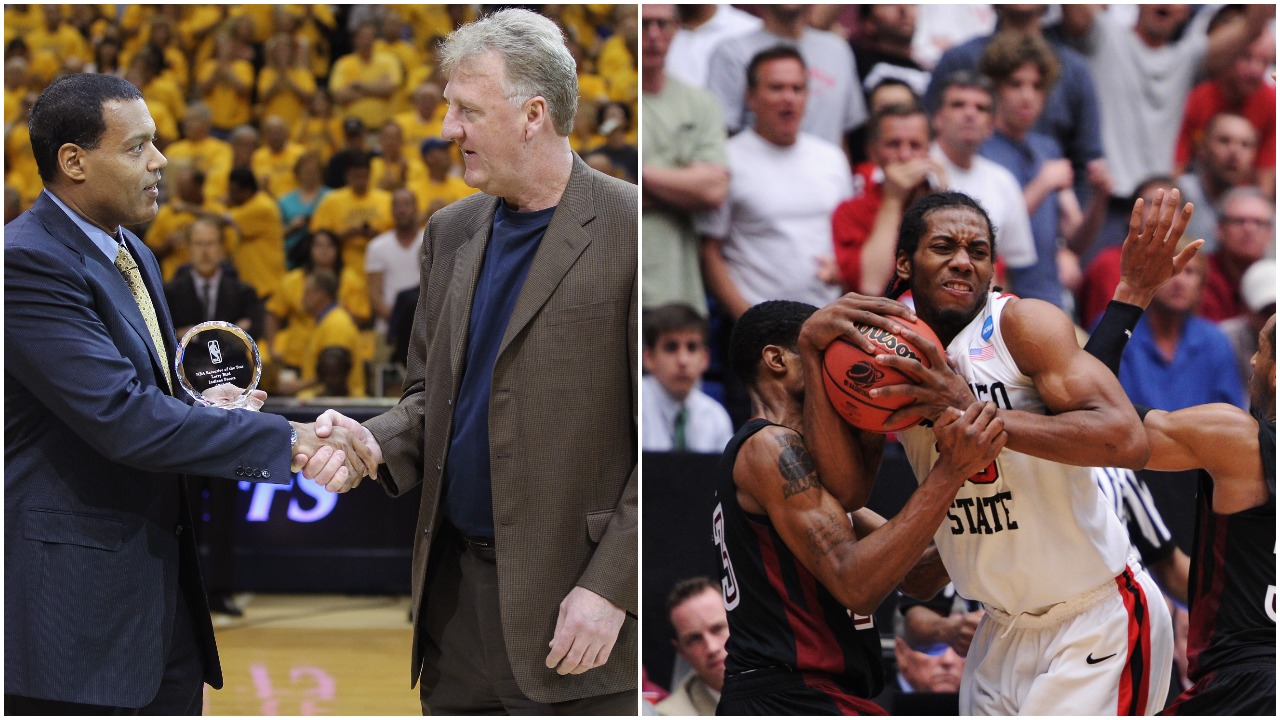NBA
Former Pacers Executive Larry Bird Predicted That His Infamous Draft-Day Trade of Kawhi Leonard Would Backfire

After making the playoffs just once in the past five years heading into the 2011 NBA Draft, Indiana Pacers team president Larry Bird felt the organization needed an aggressive move. He also recognized that said move could result in the Pacers missing out on Kawhi Leonard’s star potential.
The Pacers had a scoring machine in Danny Granger, with two-way wing Paul George showing signs of stardom and second-year center Roy Hibbert protecting the rim. Bird felt the Pacers needed another strong combo guard to complement Darren Collison.
Larry Legend ended the 2011-12 season as the first man in league history to win MVP, Coach of the Year, and Executive of the Year. But his comments regarding the decision to trade Leonard on draft night resonate more in hindsight.
Larry Bird and the Pacers traded the draft rights to Kawhi Leonard in exhange for George Hill
Larry Bird and the Pacers saw an opportunity when San Diego State swingman Kawhi Leonard began to fall in the 2011 NBA Draft.
Leonard had a standout (albeit brief) career for the Aztecs, earning All-America Second Team honors and being named a Wooden Award finalist. But a somewhat mediocre and nervy showing at the draft combine caused teams such as the Phoenix Suns to pass on The Claw.
With his club possessing the 15th overall pick, Bird shopped around and found a team that desired Leonard in the San Antonio Spurs. The Spurs sent guard George Hill to the Pacers in exchange for Leonard’s draft rights.
The deal appeared to make sense for both clubs. San Antonio did not need another backcourt player with Tony Parker on the roster and youngster Danny Green and an All-NBA Manu Ginobili at the 2-guard spot. Meanwhile, the Pacers could afford to move Leonard, considering they had strong wings in Granger and George.
Still, while the trade appeared to be a win-win, Bird acknowledged the Pacers might have given up a star-caliber player in Kawhi.
Bird understood Leonard could end up as “one hell” of a talent

Bird’s pursuit of a guard always pointed to the same guy: George Hill. The Hick from French Lick told the Indianapolis Star he tried to acquire Hill for “three years.”
Still, while the Pacers’ selection of Leonard and the roster construction of each team made a deal possible, Bird felt wary of the cost. He recalled a conversation with governor Herb Simon in which he acknowledged the kind of player he thought Kawhi could be down the road.
“I told Herbie (Simon, Pacers owner), ‘I want George Hill but we’re going to pay a price for it because this kid (Leonard) that just slipped to us is going to be one hell of a player but I think we need this for our team.'”
–Larry Bird (2013), via the Indianapolis Star
To say Leonard panned out is an understatement. Kawhi has since become one of the best players in the league and will ultimately go down as one of the greatest talents in NBA history.
So, the Pacers lost the trade, right? In hindsight, absolutely. But it’s hard to assess the deal in a vacuum.
Leonard’s steady rise to stardom coincided with the Pacers’ slide
At the time of the trade, the Pacers had only just made it back to the playoffs. Bird and the front office couldn’t stash Leonard behind Granger and George in the hopes he’d develop and eventually get a chance. Plus, George Hill excelled in Indiana.
Hill cracked the starting lineup for the 2012-13 campaign. He averaged 14.2 points, 4.7 assists, and 3.7 rebounds for an Indiana team that reached the Eastern Conference Finals and pushed the “Big 3” Miami Heat to seven games.
Here’s the thing, though. Leonard had a breakout sophomore campaign and really made an impression in the playoffs. While the Pacers made it back to the Conference Finals again in 2014, the Spurs won the NBA title, with Kawhi winning Finals MVP in the process.
To make matters worse for Indiana, knee and calf issues ruined Granger’s career. Lance Stephenson made an impact on the wing, but he wasn’t at Leonard’s level. Moreover, Stephenson’s departure in 2014, followed by George’s devastating leg injury in Team USA camp, left a massive void on the wings.
Although George returned to an All-Star level, the Pacers no longer had the pieces to contend, with Bird ultimately stepping down from his role with the franchise in 2017. Meanwhile, Leonard became an All-NBA guy who kept an aging Spurs group at or near the top of the Western Conference.
The Claw’s legend has only grown. He led the Toronto Raptors to a championship in 2019 and continues to play at an MVP level, though he’s sidelined by injury likely for the entirety of the 2021-22 season.
In the end, Bird predicted Leonard’s stardom and how the trade could eventually backfire on the Pacers, even if it’s slightly unfair to criticize Larry Legend for making the move at the time.
Stats courtesy of Basketball Reference.











